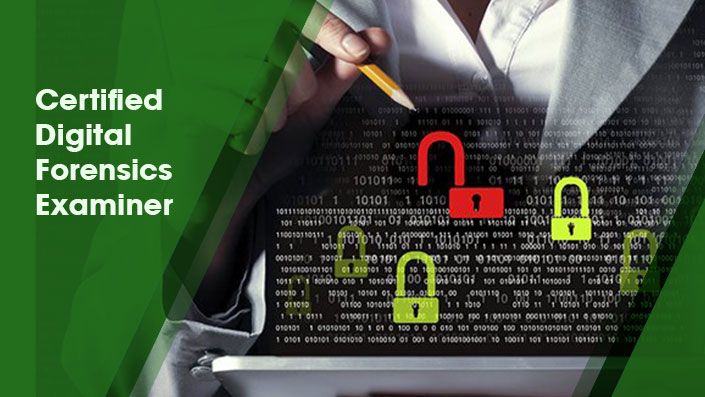
Certified Digital Forensics Examiner (CDFE)
The Certified Digital Forensics Examiner (CDFE) is a vendor neutral certification offered by Mile2 for the aspiring cyber-crime fraud investigators. The course is based on the recommended curriculum for the same certification. The course enables the students to investigate, pursue litigation, provide proof of guilt, or take corrective measures based on the evidence collected through digital media.
The Certified Digital Forensic Examiner (CDFE) course is a comprehensive training course based on the official Mile2 certification exam curriculum. The course teaches the advanced concepts such as investigation of digital forensic incidents, usual ways to identify and discover anomalies in the stored data, data acquisition, forensic examination methods and smart devices investigation techniques. The course is ideal for the candidates willing to appear for the CDFE certification exam.
Exam Information
Upon completion, Certified Digital Forensics Examiner students will be able to establish industry acceptable digital forensics standards with current best practices and policies. Students will also be prepared to competently take the CDFE exam.
Mile2 is:
- ACCREDITED by the NSA CNSS 4011-4016
- MAPPED to NIST / Homeland Security NICCS's Cyber Security Workforce Framework
- APPROVED on the FBI Cyber Security Certification Requirement list (Tier 1-3)

Prerequisites:
A minimum of 1 year in computers
Student Materials:
Student Workbook
Student Prep Guide
Certification Exams:
Mile2 CDFE - Certified Digital Forensics Examiner
Who Should Attend?
- Security Officers
- IS Managers
- Agents/Police Officers
- Attorneys
- Data Owners
- IT managers
- IS Manager/Officers
Course Curriculum
-
StartComputer Forensics Incidents (0:05)
-
StartDownload Resources
-
StartWhere are We? (0:10)
-
PreviewOverview (0:18)
-
StartSection 1: Origins of digital forensic science (0:06)
-
StartThe Legal System (0:34)
-
StartThe Legal System (1:22)
-
StartThe Legal System (0:37)
-
StartThe Legal System (1:02)
-
StartSection 2: Differences between criminal and civil incidents (0:14)
-
StartCriminal Incidents (0:32)
-
StartCriminal Incidents (0:54)
-
StartCriminal Incidents (1:41)
-
StartCriminal Incidents (0:53)
-
StartCriminal Incidents (0:59)
-
StartCriminal Incidents (0:37)
-
StartCriminal Incidents (0:45)
-
StartCivil Incidents (1:02)
-
StartCivil Incidents (0:43)
-
StartCivil Incidents (0:29)
-
StartSection 3: Types of computer fraud incidents (0:05)
-
StartComputer Fraud (0:50)
-
StartComputer Fraud (0:40)
-
StartComputer Fraud (0:51)
-
StartComputer Fraud (0:41)
-
StartSection 4: Internal and external threats (0:04)
-
StartInternal Threats (1:21)
-
StartInternal Threats (0:43)
-
StartExternal Threats (0:23)
-
StartExternal Threats (0:50)
-
StartExternal Threats (0:31)
-
StartExternal Threats (0:40)
-
StartSection 5: Investigative challenges (0:04)
-
StartInvestigative Challenges (0:20)
-
StartInvestigative Challenges (0:31)
-
StartInvestigative Challenges (0:35)
-
StartCommon Frame of Reference (0:34)
-
StartMedia Volume (0:16)
-
StartReview (0:17)
-
StartModule 1 - Quiz
-
StartIncident Handling (0:04)
-
StartOverview (0:08)
-
StartSection 1: What is an Incident? (0:06)
-
StartIncident Handling Defined (0:17)
-
StartWhat is a Security Event? (0:24)
-
StartCommon Security Events of Interest (0:29)
-
StartWhat is a Security Incident? (0:16)
-
StartWhat is an Incident Response Plan? (0:28)
-
StartWhen does the Plan get Initiated? (0:57)
-
StartCommon Goals of Incident Response Management (0:58)
-
StartSection 2: Incident Handling Steps (0:05)
-
StartIncident Handling Steps (0:15)
-
StartPhase 1: Preparation (0:04)
-
StartGoal (0:15)
-
StartBe Prepared (0:25)
-
StartThe Incident Response Plan (0:28)
-
StartIncident Handling (0:44)
-
StartIncident Response Plan (0:53)
-
StartIncident Response Plan (0:41)
-
StartIncident Response Plan (0:24)
-
StartRoles of the Incident Response Team (0:49)
-
StartIncident Response Team Makeup (0:37)
-
StartChallenges of building an IRT (0:46)
-
StartIncident Response Training and Awareness (1:16)
-
StartJump Kit (0:41)
-
StartJump Kit (1:10)
-
StartPrepare Your Sites and Systems (1:12)
-
StartPrepare Your Sites and Systems (1:08)
-
StartPrepare Your Sites and Systems (1:07)
-
StartPrepare Your Sites and Systems (1:01)
-
StartPrepare Your Sites and Systems (1:07)
-
StartPrepare Your Sites and Systems (0:48)
-
StartPhase 2: Identification and Initial Response (0:06)
-
StartGoal (0:09)
-
StartIdentification of an Incident (0:56)
-
StartBasic Incident Response Steps (1:15)
-
StartProper Evidence Handling (1:25)
-
StartPhase 3: Containment (0:04)
-
StartGoal (0:08)
-
StartContainment (0:16)
-
StartOnsite Response (0:17)
-
StartSecure the Area (0:25)
-
StartConduct Research (0:35)
-
StartMake Recommendations (0:23)
-
StartEstablish Intervals (0:19)
-
StartCapture Digital Evidence (1:26)
-
StartChange Passwords (0:31)
-
StartPhase 4: Eradication (0:04)
-
StartGoal (0:11)
-
StartDetermine Cause (0:45)
-
StartDefend Against Follow-on Attacks (0:47)
-
StartMore Defenses (1:08)
-
StartAnalyze Threat and Vulnerability (0:26)
-
StartRestore System(s) to Operation (0:56)
-
StartPhase 5: Recovery (0:04)
-
StartGoal (0:06)
-
StartReport Findings (0:11)
-
StartRestore System (0:12)
-
StartVerify (0:14)
-
StartDecide (0:10)
-
StartMonitor Systems (0:41)
-
StartPhase 6: Follow-up (0:04)
-
StartGoal (0:08)
-
StartFollow-up Report (0:44)
-
StartFollow-up Report (0:47)
-
StartReview (0:08)
-
StartModule 2 - Quiz
-
StartComputer Forensic Investigative Theory (0:06)
-
StartOverview (0:14)
-
StartSection 1: Investigation Theory (0:05)
-
StartComputer Forensic Investigative Theory (0:43)
-
StartComputer Forensic Investigative Theory (0:41)
-
StartComputer Forensic Investigative Theory (0:30)
-
StartComputer Forensic Investigative Theory (0:19)
-
StartComputer Forensic Investigative Theory (0:22)
-
StartComputer Forensic Investigative Theory (0:27)
-
StartSection 2: Investigative Concepts (0:04)
-
StartComputer Forensic Investigative Theory (0:26)
-
StartComputer Forensic Investigative Theory (1:08)
-
StartComputer Forensic Investigative Theory (0:58)
-
StartComputer Forensic Investigative Theory (0:42)
-
StartComputer Forensic Investigative Theory (0:30)
-
StartComputer Forensic Investigative Theory (0:21)
-
StartComputer Forensic Investigative Theory (0:36)
-
StartComputer Forensic Investigative Theory (0:57)
-
StartSection 3: BEA & EFA (0:05)
-
StartComputer Forensic Investigative Theory (1:02)
-
StartComputer Forensic Investigative Theory (0:43)
-
StartComputer Forensic Investigative Theory (0:22)
-
StartComputer Forensic Investigative Theory (0:20)
-
StartComputer Forensic Investigative Theory (1:24)
-
StartComputer Forensic Investigative Theory (0:44)
-
StartComputer Forensic Investigative Theory (0:39)
-
StartComputer Forensic Investigative Theory (0:25)
-
StartComputer Forensic Investigative Theory (0:29)
-
StartComputer Forensic Investigative Theory (0:47)
-
StartComputer Forensic Investigative Theory (0:25)
-
StartComputer Forensic Investigative Theory (0:19)
-
StartMcAfee Geotagging (1:22)
-
StartReview (0:15)
-
StartModule 3 - Quiz
